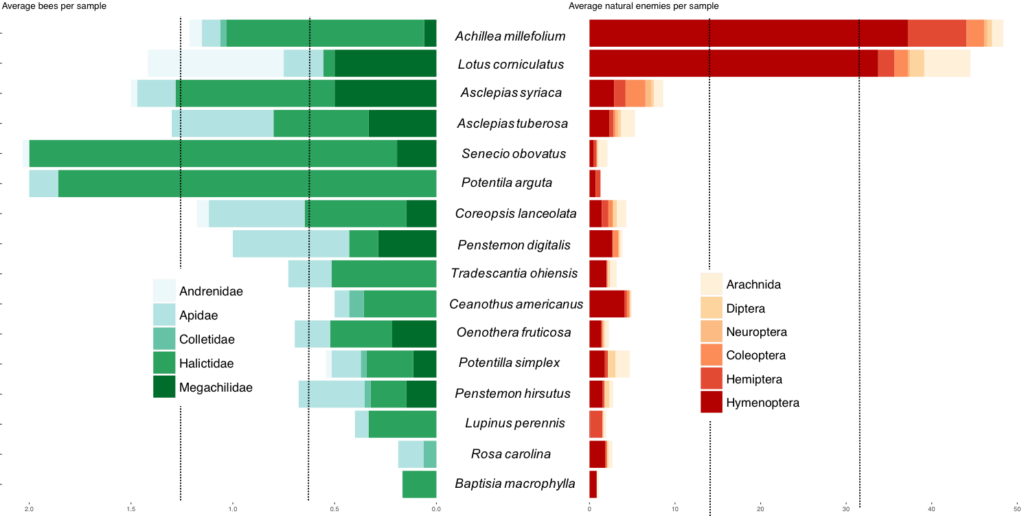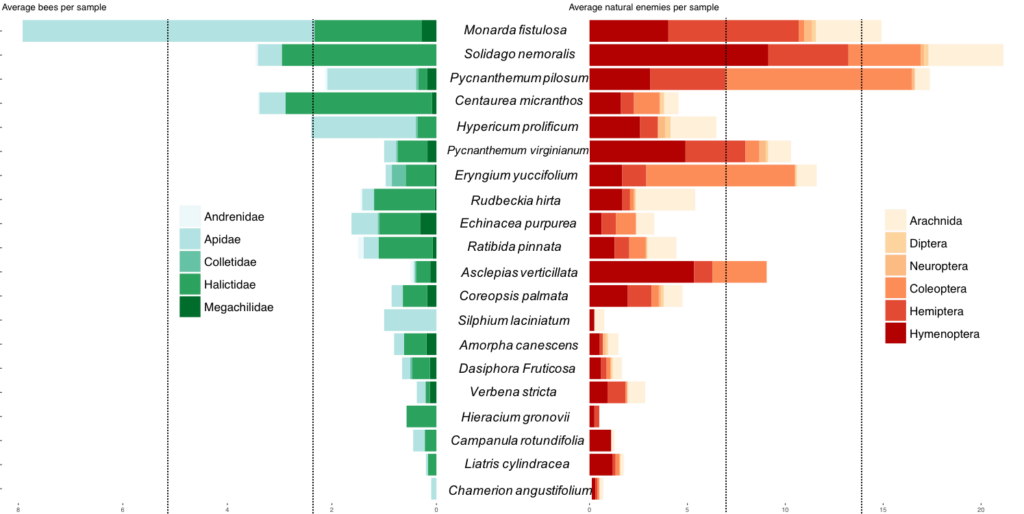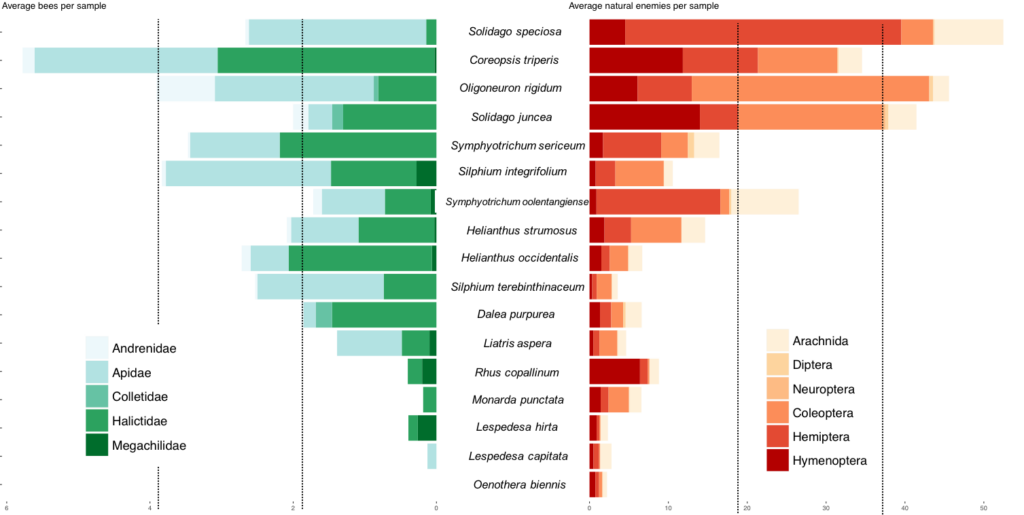Final report for LNC14-361
Project Information
The goal of this project was to conduct research and education to increase the availability of insectary plants to enhance beneficial insects in the North-Central Region. In 2015-2016, we conducted weekly sampling of natural enemy and pollinator abundance on 54 species of plants in three common-garden research sites located at: Southwest Michigan Research and Extension Center (SWMREC), the Clarksville Research Center (CRC), and the Northwest Michigan Horticultural Research Center (NWMHRC). Overall, our data show that many native plant species are highly attractive to both pollinators and natural enemies with floral area being the best predictor of attractiveness. Among the species we tested, plants can be selected from early, mid, and late bloom periods to provide continuous resources for pollinators and natural enemies throughout the growing season. Stakeholders were informed of our results through field days, extension presentations, a dedicated website, scientific talks and peer reviewed publications.
Objectives
- Improved stakeholder knowledge of which insectary plants best support pest-controlling and pollinating insects, especially for use in dry soils.
- Increased access to “best practices” for establishing and maintaining insectary habitats through peer-reviewed research publications, an extension bulletin, annual demonstration field-days at multiple locations, webinars, and website development.
- Improved understanding of the benefits of multi-floral resources for beneficial insects.
- Enhanced land manager skills in utilizing insectary plants to support arthropod-mediated ecosystem services in farmland.
Cooperators
Research
Accomplishments/Milestones
Two graduate students successfully completed their Masters degree’s based on the research they conducted for the project.
Logan Rowe. Evaluation of Wildflowers to Provide Foraging Resources for Managed and Wild Pollinators in Michigan. MS thesis, Michigan State University (2017)
Daniel Gibson. Screening Michigan native wildflowers for attractiveness to natural enemies. MS Plan B. Michigan State University (2018)
The outcomes of the research are being transmitted to the scientific community via peer-reviewed publications.
Rowe, L., Gibson, D., Landis, D., Gibbs, J., & Isaacs, R. (2018). A Comparison of Drought-Tolerant Prairie Plants to Support Managed and Wild Bees in Conservation Programs. Environmental Entomology, 47(5), 1128-1142.
Rowe L., Gibson D., Bahlai C., Gibbs J., Landis D., Isaacs R. “Plant traits associated with community structure and visitation patterns of taxonomically and functionally distinct bee groups.” Oecologia, In review.
Gibson D., Rowe L., Isaacs R., & Landis D. Testing Michigan native perennials as potential insectary plants for supporting natural enemies. Environmental Entomology. In preparation.
Rowe, L., D. Gibson, J. Gibbs, D Landis, R Isaacs. A dataset consisting of plant traits, bee species and their visitation rates to native Michigan wildflowers. For Ecological Archives.
Grant support leveraged
Enhancing Great Lakes landscapes for healthy pollinators. Isaacs, R., Landis, D., Gibbs, J., Milbrath, M., Gut, L.J., Szendrei, Z. and Wilson, J. USDA-NIFA. $999,882. 2/1/17-1/31/20.



Education
We used a combination of field days, talks at extension meetings and commodity Expo events, and workshops to educate stakeholders about our results. We also made our results available through a website on native plants and ecosystem services
Educational & Outreach Activities
Participation Summary:
Stakeholders were informed about the project results through our 2016 field day which drew 200 participants, multiple extension and scientific presentations, and a workshop held for master gardeners in 2017. An extension bulletin detailing our results is anticipated for summer 2019. In addition, our Native Plants and Ecosystem Services website has been completely redesigned. It now includes a newsfeed articles related to the overall topic of native plants and ecosystem services. A plant selector tool has also been developed and made live on the website. It currently includes plants that we previously tested in other research. Results from our current research will be added to the plant selector tool as they become available. Since January 2015 there were over 340,000 pageviews and the site is currently receiving approximately 200 pageviews per day.
Field Days/Workshops
Landis, DA, D Gibson, L Rowe, J Perrone, R Isaacs. Supporting Beneficial Insects with Flowering Plants. NC SARE Insectary Plant project field day. August 2, 2016, Clarksville Research Center. Lead organizer. 120 attendees.
Landis, DA, D Gibson, L Rowe, J Perrone .Using Beneficial Natural Enemies to Control Pests in Your Garden or Home Landscape. Master Gardener College Workshop, June 23, 2017. (3h lecture and lab). PowerPoint presentation: Native Plants to Enhance Natural Enemies.
Gibson, DR. March 2017. Natural enemies and native plant habitat. Presentation to Pattengill Middle School students. Lansing, MI.
Invited Research Talks
Logan Rowe and Rufus Isaacs. Native wildflowers for pollinator habitat: From plant selection to habitat management. Michigan Beekeepers Association Conference. East Lansing, MI, March 9-10, 2018. (invited presentation)
Rufus Isaacs. Integrated crop pollination, in theory and practice. Department of Entomology, University of Wisconsin, Madison, WI. October 12, 2018.
Rufus Isaacs. Bees and blooms for bigger berries. University of Idaho, Moscow, ID. E. Paul Catts Memorial Lecture. April 19, 2018.
Rufus Isaacs. Lessons from pollinator conservation in agricultural lands. Energy Policy Research Institute – Pollinator Workshop. Washington DC, April 25 2017.
Rufus Isaacs. Diversifying strategies for pollination of specialty crops. Arid Lands Agricultural Research Center, Maricopa, AZ. April 6, 2017.
Rufus Isaacs. Integrated crop pollination for sustainable blueberry yields. Department of Entomology, University of Georgia, Athens, GA. November 14, 2016.
Extension Talks
Gibson, DR, L Rowe, R Isaacs, and DA Landis. January 2017. Michigan native plants to attract beneficial natural enemies in agriculture. Stewardship Network: The Science, Practice & Art of Restoring Native Ecosystems. East Lansing, MI. (poster)
Gibson, DR, L Rowe, R Isaacs, and DA Landis. March 2017. Integrating agriculture and ecological restoration: Native wildflowers can support natural pest suppression. Society for Ecological Restoration MWGL Chapter Meeting. Grand Rapids, MI. Best Student Oral Presentation, SER-MWGL Chapter Meeting 2017
Isaacs, R. Pollinator-friendly solar: setting state standards. Rights of Way as Habitat Working Group. Webinar on October 3, 2018. 68 attendees.
Isaacs, R. Healthy bees for profitable farms. Healthy soil, healthy farms event. Providence Organic Farm and CSA. Central Lake, MI. August 30, 2018. 40 growers and conservation technicians.
Isaacs, R. MSU pollinator research. APLU agricultural research reception. Rayburn Office Building, Washington, D.C. June 6, 2018.
Isaacs, R. Natural enemies in the vineyard. Spring grape meeting, NWMHRS, Traverse City, MI. June 1, 2018. 26 growers.
Isaacs, R. Pollinator Health Listening Session. Ottawa County Extension Office, West Olive, MI. May 9, 2018. 12 people.
Isaacs, R. Pre-bloom blueberry extension meeting. Port Sheldon Township Hall. May 2, 2018. 43 growers.
Isaacs, R. Great Lakes Sustainable Winegrape Growers, Pest Management Group. Tabor Hill vineyard. April 27, 2018.
Isaacs, R. Pollinator Health Listening Session. Saginaw Valley Research Center, Frankenmuth, MI. May 17, 2018. 33 people.
Isaacs, R. Pollinator Health Listening Session. NWMHRS, Traverse City, MI. May 16, 2018. 36 people.
Isaacs, R. Small Fruit Entomology Program Update. Michigan State Horticultural Society Board Meeting. Clarksville Research Center, Clarksville, MI. June 7, 2017. 6 growers.
Isaacs, R. Wild bees of Michigan (focus on Bombus affinis). US Fish and Wildlife Service, East Lansing, Michigan. April 14, 2017. 18 people.
Isaacs, R. Pollinator habitat. What is it, and how can I add some to my farm? Southwest Hort Days, Benton Harbor, MI. February 1, 2017. 26 people.
Isaacs, R. Bees, Blooms, and Bigger Berries. Banquet speaker for the Holland Area Beekeepers Annual Meeting, Hamilton, MI. January 14, 2017.
Rowe, L. D. Gibson, D. Landis, R. Isaacs. Habitat management to support beneficial insects: selecting the right plant species. The Science, Practice, and Art of Restoring Native Ecosystems. East Lansing, MI, January 12-13, 2018. (presentation)
Rowe, L. D. Gibson, R. Isaacs, D. Landis. Variation in Plant Attractiveness to Pollinators in 3 Regions of Michigan. The Science, Practice, and Art of Restoring Native Ecosystems. East Lansing, MI, January 13-14, 2017. (poster)
Rowe, L. D. Gibson, D. Landis, R. Isaacs. Plant selection to support pollinators and natural enemies in Michigan farm landscapes and beyond. Entomological Society of America. Denver, Colorado, November 5-8th, 2017. (invited presentation)